check engine PONTIAC TORRENT 2007 Owner's Guide
[x] Cancel search | Manufacturer: PONTIAC, Model Year: 2007, Model line: TORRENT, Model: PONTIAC TORRENT 2007Pages: 490, PDF Size: 2.71 MB
Page 363 of 490
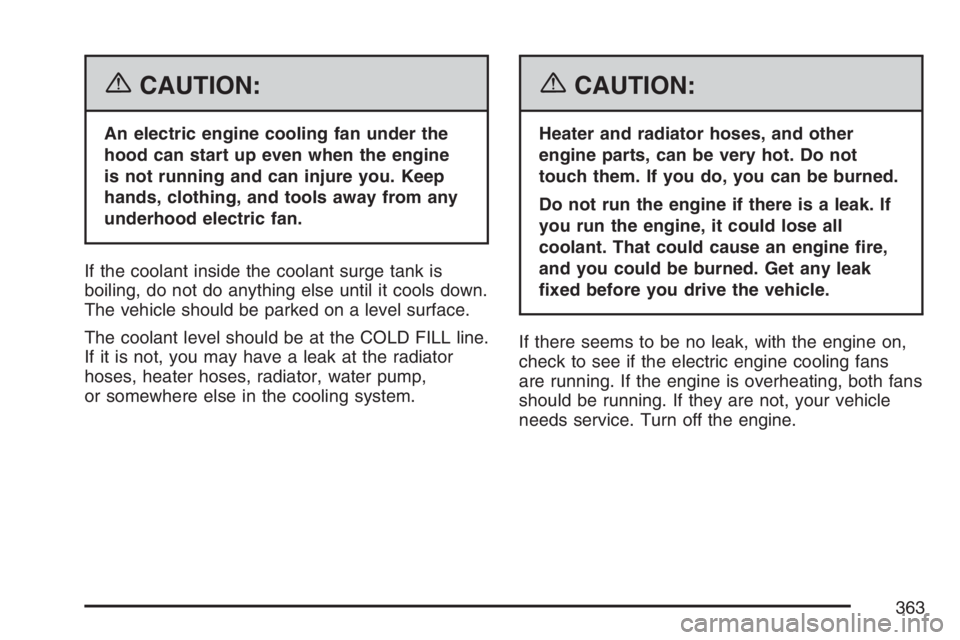
{CAUTION:
An electric engine cooling fan under the
hood can start up even when the engine
is not running and can injure you. Keep
hands, clothing, and tools away from any
underhood electric fan.
If the coolant inside the coolant surge tank is
boiling, do not do anything else until it cools down.
The vehicle should be parked on a level surface.
The coolant level should be at the COLD FILL line.
If it is not, you may have a leak at the radiator
hoses, heater hoses, radiator, water pump,
or somewhere else in the cooling system.
{CAUTION:
Heater and radiator hoses, and other
engine parts, can be very hot. Do not
touch them. If you do, you can be burned.
Do not run the engine if there is a leak. If
you run the engine, it could lose all
coolant. That could cause an engine �re,
and you could be burned. Get any leak
�xed before you drive the vehicle.
If there seems to be no leak, with the engine on,
check to see if the electric engine cooling fans
are running. If the engine is overheating, both fans
should be running. If they are not, your vehicle
needs service. Turn off the engine.
363
Page 364 of 490
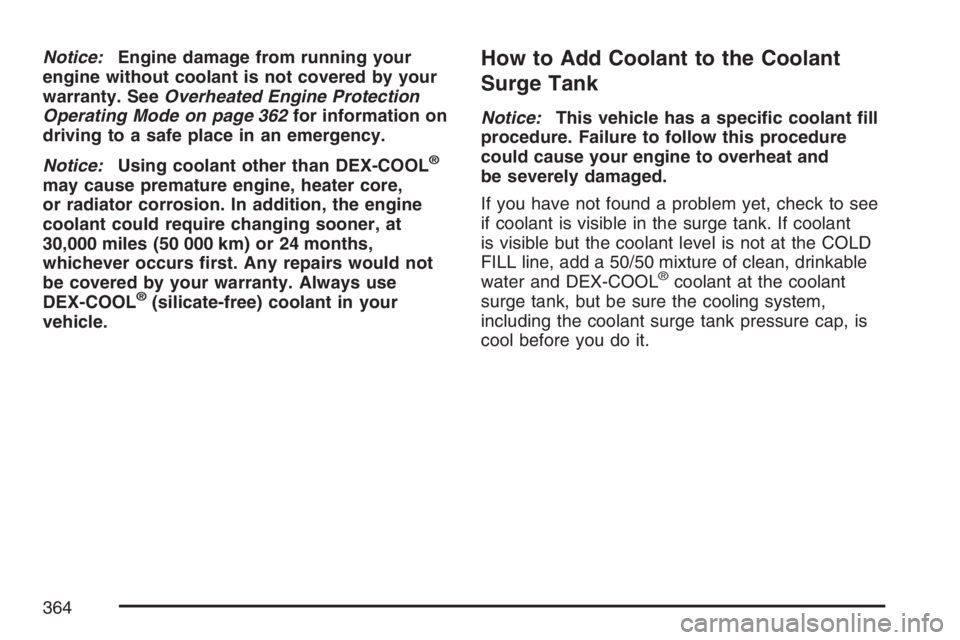
Notice:Engine damage from running your
engine without coolant is not covered by your
warranty. SeeOverheated Engine Protection
Operating Mode on page 362for information on
driving to a safe place in an emergency.
Notice:Using coolant other than DEX-COOL
®
may cause premature engine, heater core,
or radiator corrosion. In addition, the engine
coolant could require changing sooner, at
30,000 miles (50 000 km) or 24 months,
whichever occurs �rst. Any repairs would not
be covered by your warranty. Always use
DEX-COOL
®(silicate-free) coolant in your
vehicle.
How to Add Coolant to the Coolant
Surge Tank
Notice:This vehicle has a speci�c coolant �ll
procedure. Failure to follow this procedure
could cause your engine to overheat and
be severely damaged.
If you have not found a problem yet, check to see
if coolant is visible in the surge tank. If coolant
is visible but the coolant level is not at the COLD
FILL line, add a 50/50 mixture of clean, drinkable
water and DEX-COOL
®coolant at the coolant
surge tank, but be sure the cooling system,
including the coolant surge tank pressure cap, is
cool before you do it.
364
Page 368 of 490
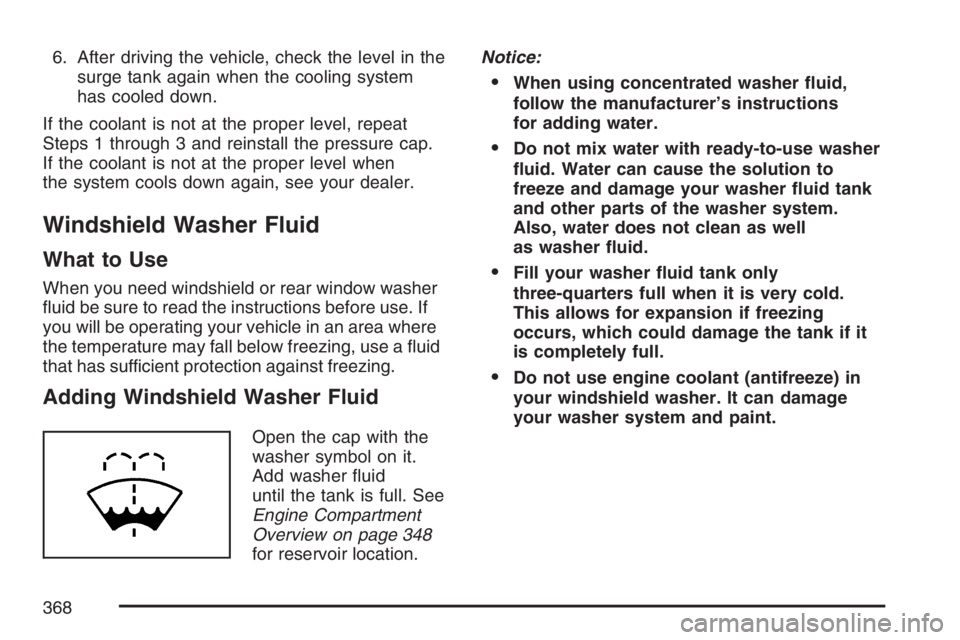
6. After driving the vehicle, check the level in the
surge tank again when the cooling system
has cooled down.
If the coolant is not at the proper level, repeat
Steps 1 through 3 and reinstall the pressure cap.
If the coolant is not at the proper level when
the system cools down again, see your dealer.
Windshield Washer Fluid
What to Use
When you need windshield or rear window washer
�uid be sure to read the instructions before use. If
you will be operating your vehicle in an area where
the temperature may fall below freezing, use a �uid
that has sufficient protection against freezing.
Adding Windshield Washer Fluid
Open the cap with the
washer symbol on it.
Add washer �uid
until the tank is full. See
Engine Compartment
Overview on page 348
for reservoir location.Notice:
When using concentrated washer �uid,
follow the manufacturerŌĆÖs instructions
for adding water.
Do not mix water with ready-to-use washer
�uid. Water can cause the solution to
freeze and damage your washer �uid tank
and other parts of the washer system.
Also, water does not clean as well
as washer �uid.
Fill your washer �uid tank only
three-quarters full when it is very cold.
This allows for expansion if freezing
occurs, which could damage the tank if it
is completely full.
Do not use engine coolant (antifreeze) in
your windshield washer. It can damage
your washer system and paint.
368
Page 376 of 490

5. Check that the jumper cables do not have
loose or missing insulation. If they do, you
could get a shock. The vehicles could
be damaged, too.
Before you connect the cables, here are some
basic things you should know. Positive (+)
will go to positive (+) or to a remote positive (+)
terminal if the vehicle has one. Negative (ŌłÆ)
will go to a heavy, unpainted metal engine part
or to a remote negative (ŌłÆ) terminal if the
vehicle has one.
Do not connect positive (+) to negative (ŌłÆ)or
you will get a short that would damage
the battery and maybe other parts, too. And
do not connect the negative (ŌłÆ) cable to
the negative (ŌłÆ) terminal on the dead battery
because this can cause sparks.6. Connect the red positive (+) cable to the
positive (+) terminal of the dead battery.
Use a remote positive (+) terminal if
the vehicle has one.
7. Do not let the other end touch metal. Connect
it to the positive (+) terminal of the good
battery. Use a remote positive (+) terminal if
the vehicle has one.
8. Now connect the black negative (ŌłÆ) cable to
the negative (ŌłÆ) terminal of the good battery.
Use a remote negative (ŌłÆ) terminal if the
vehicle has one.
Do not let the other end touch anything until
the next step. The other end of the negative (ŌłÆ)
cable does not go to the dead battery. It
goes to a heavy, unpainted metal engine part
or to a remote negative (ŌłÆ) terminal on the
vehicle with the dead battery.
376
Page 436 of 490
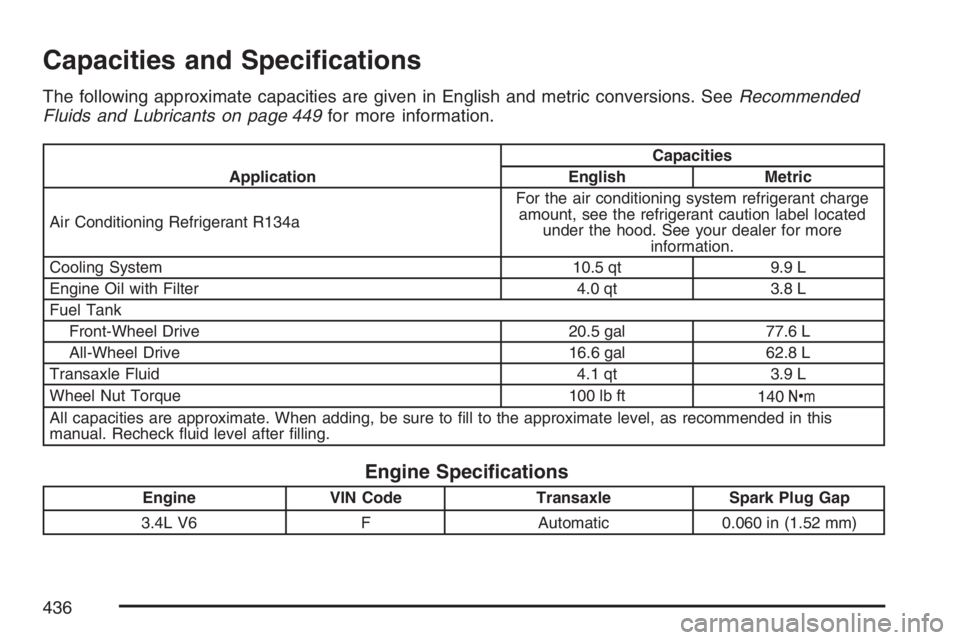
Capacities and Speci�cations
The following approximate capacities are given in English and metric conversions. SeeRecommended
Fluids and Lubricants on page 449for more information.
ApplicationCapacities
English Metric
Air Conditioning Refrigerant R134aFor the air conditioning system refrigerant charge
amount, see the refrigerant caution label located
under the hood. See your dealer for more
information.
Cooling System 10.5 qt 9.9 L
Engine Oil with Filter 4.0 qt 3.8 L
Fuel Tank
Front-Wheel Drive 20.5 gal 77.6 L
All-Wheel Drive 16.6 gal 62.8 L
Transaxle Fluid 4.1 qt 3.9 L
Wheel Nut Torque 100 lb ft
140Y
All capacities are approximate. When adding, be sure to �ll to the approximate level, as recommended in this
manual. Recheck �uid level after �lling.
Engine Speci�cations
Engine VIN Code Transaxle Spark Plug Gap
3.4L V6 F Automatic 0.060 in (1.52 mm)
436
Page 437 of 490
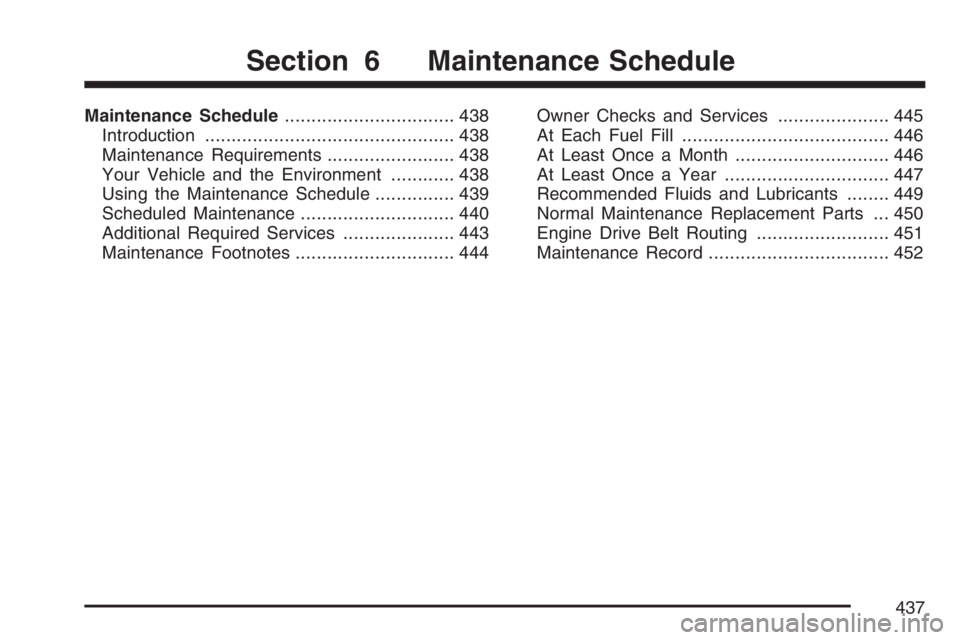
Maintenance Schedule................................ 438
Introduction............................................... 438
Maintenance Requirements........................ 438
Your Vehicle and the Environment............ 438
Using the Maintenance Schedule............... 439
Scheduled Maintenance............................. 440
Additional Required Services..................... 443
Maintenance Footnotes.............................. 444Owner Checks and Services..................... 445
At Each Fuel Fill....................................... 446
At Least Once a Month............................. 446
At Least Once a Year............................... 447
Recommended Fluids and Lubricants........ 449
Normal Maintenance Replacement Parts ... 450
Engine Drive Belt Routing......................... 451
Maintenance Record.................................. 452
Section 6 Maintenance Schedule
437
Page 438 of 490

Maintenance Schedule
Introduction
Important: Keep engine oil at the proper level
and change as recommended.
Have you purchased the GM Protection Plan? The
Plan supplements your new vehicle warranties.
See your Warranty and Owner Assistance booklet
or your dealer for details.
Maintenance Requirements
Notice:Maintenance intervals, checks,
inspections, replacement parts, and
recommended �uids and lubricants as
prescribed in this manual are necessary to
keep your vehicle in good working condition.
Any damage caused by failure to follow
scheduled maintenance may not be covered by
warranty.
Your Vehicle and the Environment
Proper vehicle maintenance not only helps to keep
your vehicle in good working condition, but also
helps the environment. All recommended
maintenance is important. Improper vehicle
maintenance can even affect the quality of the air
we breathe. Improper �uid levels or the wrong
tire in�ation can increase the level of emissions
from your vehicle. To help protect our environment,
and to keep your vehicle in good condition, be
sure to maintain your vehicle properly.
438
Page 440 of 490

When you go to your GM Goodwrench®dealer for
your service needs, you will know that GM-trained
and supported service technicians will perform
the work using genuine GM parts.
If you want to purchase service information, see
Service Publications Ordering Information on
page 474.
Owner Checks and Services on page 445tells you
what should be checked, when to check it, and
what you can easily do to help keep your vehicle in
good condition.
The proper replacement parts, �uids, and
lubricants to use are listed inRecommended
Fluids and Lubricants on page 449andNormal
Maintenance Replacement Parts on page 450.
When your vehicle is serviced, make sure these
are used. All parts should be replaced and all
necessary repairs done before you or anyone else
drives the vehicle. We recommend the use of
genuine GM parts.Scheduled Maintenance
When the change engine oil light and/or CHANGE
ENGINE OIL SOON message comes on, it
means that service is required for your vehicle.
Have your vehicle serviced as soon as possible
within the next 600 miles (1 000 km). It is possible
that, if you are driving under the best conditions,
the engine oil life system may not indicate
that vehicle service is necessary for over a year.
However, the engine oil and �lter must be changed
at least once a year and at this time the system
must be reset. Your GM Goodwrench
®dealer has
GM-trained service technicians who will perform
this work using genuine GM parts and reset
the system.
If the engine oil life system is ever reset
accidentally, you must service your vehicle within
3,000 miles (5 000 km) since your last service.
Remember to reset the oil life system whenever
the oil is changed. SeeEngine Oil Life System on
page 352for information on the Engine Oil Life
System and resetting the system.
440
Page 441 of 490

When the change engine oil light and/or CHANGE
ENGINE OIL SOON message appears, certain
services, checks, and inspections are required.
Required services are described in the following
for ŌĆ£MaintenanceIŌĆØ and ŌĆ£MaintenanceII.ŌĆØ
Generally, it is recommended that your �rst service
be MaintenanceI, your second service be
MaintenanceII, and that you alternate
MaintenanceIand MaintenanceIIthereafter.
However, in some cases, MaintenanceIImay be
required more often.MaintenanceIŌĆö Use MaintenanceIif the
light/message comes on within 10 months since
the vehicle was purchased or MaintenanceII
was performed.
MaintenanceIIŌĆö Use MaintenanceIIif the
previous service performed was MaintenanceI.
Always use MaintenanceIIwhenever the
light/message comes on 10 months or more since
the last service or if the light/message has not
come on at all for one year.
441
Page 442 of 490

Scheduled Maintenance
Service MaintenanceIMaintenanceII
Change engine oil and �lter. SeeEngine Oil on page 349. Reset oil life system.
SeeEngine Oil Life System on page 352.An Emission Control Service.ŌĆóŌĆó
Visually check for any leaks or damage.See footnote (k).ŌĆóŌĆó
Inspect engine air cleaner �lter. If necessary, replace �lter. SeeEngine Air
Cleaner/Filter on page 354.See footnote (l).ŌĆó
Rotate tires and check in�ation pressures and wear. SeeTire Inspection and
Rotation on page 399and ŌĆ£Tire Wear InspectionŌĆØ inAt Least Once a Month on
page 446.ŌĆóŌĆó
Inspect brake system.See footnote (a).ŌĆóŌĆó
Check engine coolant and windshield washer �uid levels and add �uid as
needed.ŌĆóŌĆó
Perform any needed additional services. See ŌĆ£Additional Required ServicesŌĆØ in
this section.ŌĆóŌĆó
Inspect suspension and steering components.See footnote (b).ŌĆó
Inspect engine cooling system.See footnote (c).ŌĆó
Inspect wiper blades.See footnote (d).ŌĆó
Inspect restraint system components.See footnote (e).ŌĆó
Lubricate body components.See footnote (f).ŌĆó
Replace passenger compartment air �lter.See footnote (g).ŌĆó
Inspect throttle system.See footnote (j).ŌĆó
442